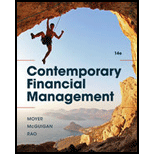
a.
To compute: Indifference points of EBIT and EPS.
a.
Explanation of Solution
Given information:
Tax rate: 40%
Average EBIT level: $6 million (per year)
Calculating EBIT-EPS indifference point:
Indifference can be seen, when debt financing EPS is considered equals to equity financing EPS,
Now,
Therefore, the indifference point will be seen when EBIT become $2.4million
b.
To compute: Earning per share for financial plan 1 and plan 2.
b.
Explanation of Solution
Calculating EPS for both financial plans:
| Plan 1 ($) | Plan 2 ($) | |
| EBIT | 6.0 | 6.0 |
| Interest | 0.0 | 1.2 |
| Earning before tax | 6.0 | 4.8 |
| Tax@40% | 2.4 | 1.92 |
| Earnings after tax | 3.6 | 2.88 |
| Outstanding shares | 2.0 | 1.0 |
| EPS | 1.80 | 2.88 |
Table (1)
Therefore, the earning per share for Plan 1 will be $1.80 and Plan 2 will be $2.88
c.
To determine: Factors for financial planning.
c.
Explanation of Solution
The factors for financial planning are as mentioned below:
- Capital structure, which is effectively followed by the parent company.
- Impact of financial plan on the financial status as well as stocks prices of the company.
- Probability distribution as per the expectation identified through EBIT.
d.
To determine: Suitable financial plan.
d.
Explanation of Solution
The plan 2 is must be recommended, because EPS (debt financing) is higher the EPS (equity financing).
e.
To compute: Earning per share when sales decreases by 5%.
e.
Explanation of Solution
Therefore, the time interest earned ratio will be 5 times.
f.
To compute: EBIT dropping level.
f.
Explanation of Solution
Therefore, the EBIT is supposed be drop by $1.8 (after deducting current EBIT from lower level). Along with that, it is required for the company to compliance with the agreement of loan.
g.
To compute: Probability of negative EPS.
g.
Explanation of Solution
Calculating earnings per share negative probability:
From Table V, the probability of a value greater than 2.0 standard deviations to the left of the mean is 2.28%, i.e. small.
Therefore, the probability of negative earning per share will be 2.28%.
Want to see more full solutions like this?
Chapter 14 Solutions
Contemporary Financial Management, Loose-leaf Version
- What is the 4% rule in retirement planning in finance?arrow_forward(Calculating NPV) Carson Trucking is considering whether to expand its regional service center in Moab, Utah. The expansion will require the expenditure of $10,000,000 on new service equipment and will generate annual net cash inflows from reduced costs of operations equal to $2,500,000 per year for each of the next 8 years. In year 8, the firm will also get back a cash flow equal to the salvage value of the equipment, which is valued at $1 million. Thus, in year 8, the investment cash inflow will total $3,500,000. Calculate the project's NPV using a discount rate of 9 percent. If the discount rate is 9 percent, then the project's NPV is (round your answer to the nearest dollar) Sarrow_forward(Calculating annuity payments) The Aggarwal Corporation needs to save $7 million to retire a(n) $7 million mortgage that matures in 17 years. To retire this mortgage, the company plans to put a fixed amount into an account at the end of each year for 17 years. The Aggarwal Corporation expects to earn 13 percent annually on the money in this account. What equal annual contribution must the firm make to this account to accumulate the $7 million by the end of 17 years? The equal annual contribution Aggarwal must make to this account is (round your answer to the nearest cent) $.arrow_forward
- (Calculating NPV) Big Steve's Swizzle Sticks is considering the purchase of a new plastic stamping machine. This investment will require an initial outlay of $95,000 and will generate net cash inflows of $17,000 per year for 11 years. a. What is the project's NPV using a discount rate of 13 percent? Should the project be accepted? Why or why not? b. What is the project's NPV using a discount rate of 14 percent? Should the project be accepted? Why or why not? c. What is this project's IRR? Should the project be accepted? Why or why not?arrow_forwardThe number of years it will take for $490 to grow to $1,057.86 at 7 percent compounded annually is (type your answer in years, round to one decimal place) years.arrow_forwardThe number of years it will take for $500 to grow to $1,039.50 at 5 percent compounded annually is (type your answer in years, round to one decimal place) years.arrow_forward
- (Round your answer to the nearest cent.) $5,000 invested for 10 years at 10 percent compounded annually will accumulate to $arrow_forwardWhat is the difference between operating leverage and financial leverage in finance? i need coarrow_forwardWhat is the Sharpe ratio and how is it used to evaluate investments? need helparrow_forward
 EBK CONTEMPORARY FINANCIAL MANAGEMENTFinanceISBN:9781337514835Author:MOYERPublisher:CENGAGE LEARNING - CONSIGNMENT
EBK CONTEMPORARY FINANCIAL MANAGEMENTFinanceISBN:9781337514835Author:MOYERPublisher:CENGAGE LEARNING - CONSIGNMENT
